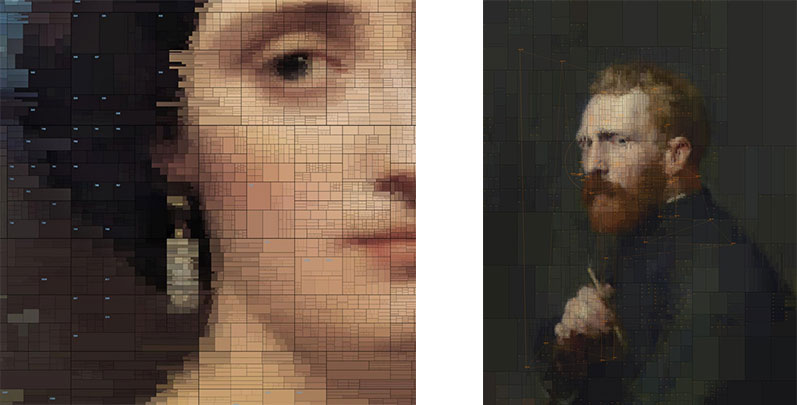
AI + Creation, the new equation
DecodingsUntil now, AI has mainly addressed the structure of functional organization, but increasingly it is challenging the creative spheres of art, music and design as well as communication sectors.
Since a previous NellyRodi article of early 2017 on how AI is disrupting the creative process, artificial intelligence has now become a reality in the media and operational marketing. Among other things, it is used for semantic analysis to process insights, processing data to optimize media deployment and predictive lead scoring by AI-enabled CRM systems. Moreover, its connection with the issues surrounding data is growing ever closer.
Among creatives, “generative design” is the new playing field and while we still don’t know how to reproduce random creativity without human intervention, the application concepts that make AI a force to be reckoned with in the creative process are opening up unexplored horizons and paving the way for new market specificities.
Revolutionary applications
Insofar as the music industry is concerned, in early 2018 Wired magazine saluted “the first convincing album of AI music“, i.e. the album Hello World curated by the French artist SKYGGE. The outlook for AI in the world of sound has been expanding with increasingly sophisticated services.
The startup Museek (which raised 1.2 million euros in November 2018) caters to audiovisual creatives and is shaking up the sector with a solution that generates pieces of music to go with visual content (e.g. for clips or videos). At the same time, big companies are contributing to these advances, such as the Facebook Artificial Intelligence Research Lab, which has attracted attention for its research on an AI system that takes audio input, including music played by humans, and outputs different types of music.
In the same vein, the recent partnership between Warner Music and Endel is rocking the boat with regard to audio consumption. It aims to create, not music, but “personalized, sound-based, adapted environments that help people focus and relax”.
Other industries are also picking up on the idea of “the science of the right mix”. In the realm of photography, software like GauGAN by Nvidia – about to reach the market – or Meero can transform sketches into photorealistic images. Once the user has provided the outlines of a landscape with fields of solid color, the algorithm adds hues, texture and detail.
In addition to the artists – the consumers for these potentialities – other creatives are exploring the possibilities of AI, such as the Dimitris Ladopoulos, the Greek art director and visual designer, or creative new media agencies like the Ouchhh in Istanbul, which is striking a chord with a segment of the public interested in more poetic takes on the subject.
New potentialities for communication
In parallel, AI is a hot topic in the world of communication.
By way of an illustration, at the last Adweek held in London, a spot ad created by IBM’s Watson for Lexus figured as an industry milestone. Having digested 15 years’ worth of award-winning automobile ads, the AI came up a very effective script, basing it on the data that generated the most emotion.
Finally, insofar as the practicalities of customer relations are concerned, the rise of companies like Phrasee, which offers to help brands write e-mails and digital marketing tailored to their target audiences, shows that the future lies in understanding consumers’ emotional triggers.
What will tomorrow bring for the concept developer?
Given these developments, the question of the future role of the designer/concept developer is progressively being raised.
Back in the Fifties, the trail-blazing cybernetic artist Nicolas Schöffer predicted that, henceforth, the artist would be “creating creation” instead of artworks. Today’s advances prove him right. AI can be used to program independent processes that will create art, with man and machine collaborating in a set process of co-creation.
More recently, and despite the fear of bias in the technology itself, the Berlin-based designer Andreas Läufer sought to allay the fears of his colleagues about AI design in an interview with the digital magazine T3n: “Why not be glad that programs like 3D Dreamcatcher help us save time? Ultimately, don’t we enjoy developing emotion-eliciting concepts more than testing 50 fonts?” Tim Cook, CEO of Apple, has a similar take: “AI design will allow creatives to concentrate on their real jobs.”
The specialized media doesn’t believe that AI will engender a decrease in creativity or replace humans. On the contrary, WIRED has announced that AI is the end of code, paving the way for new job categories such as Algorithm Designer, Creative Intelligence Designer, AI Art Director and AI Scientist.
Like ar(t)chitects today, they will be juggling science (real) and creativity (abstract). If so, then the role of concept developer will call for making the right choices and fine-tuning more than taking a “hit or miss” approach. Specifying objectives and constraints will enable him or her to remain the author of the process while facilitating implementation of emotional solutions that fit requirements and current design codes better.
Cover credits © Dimitris Ladopoulos



